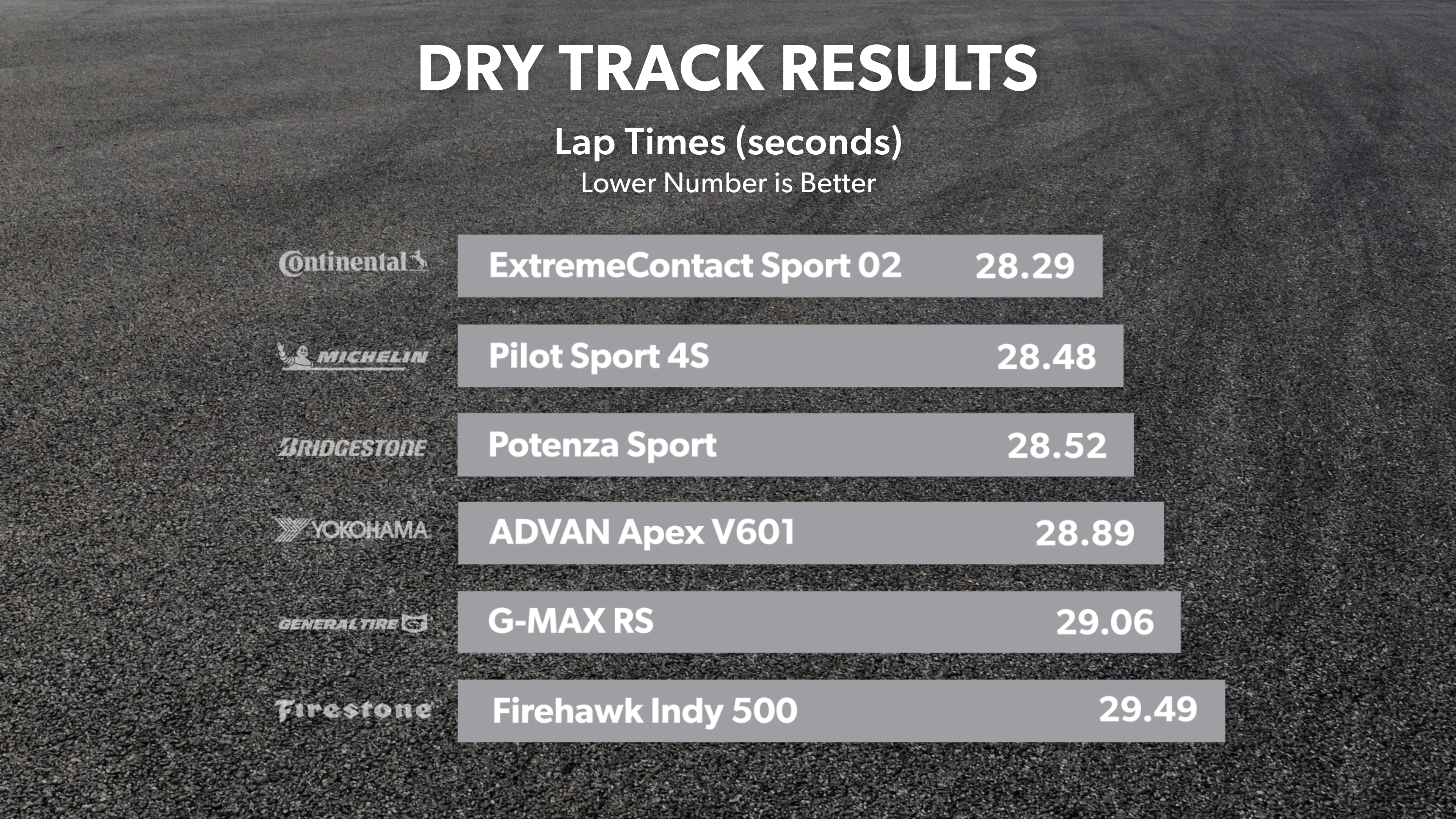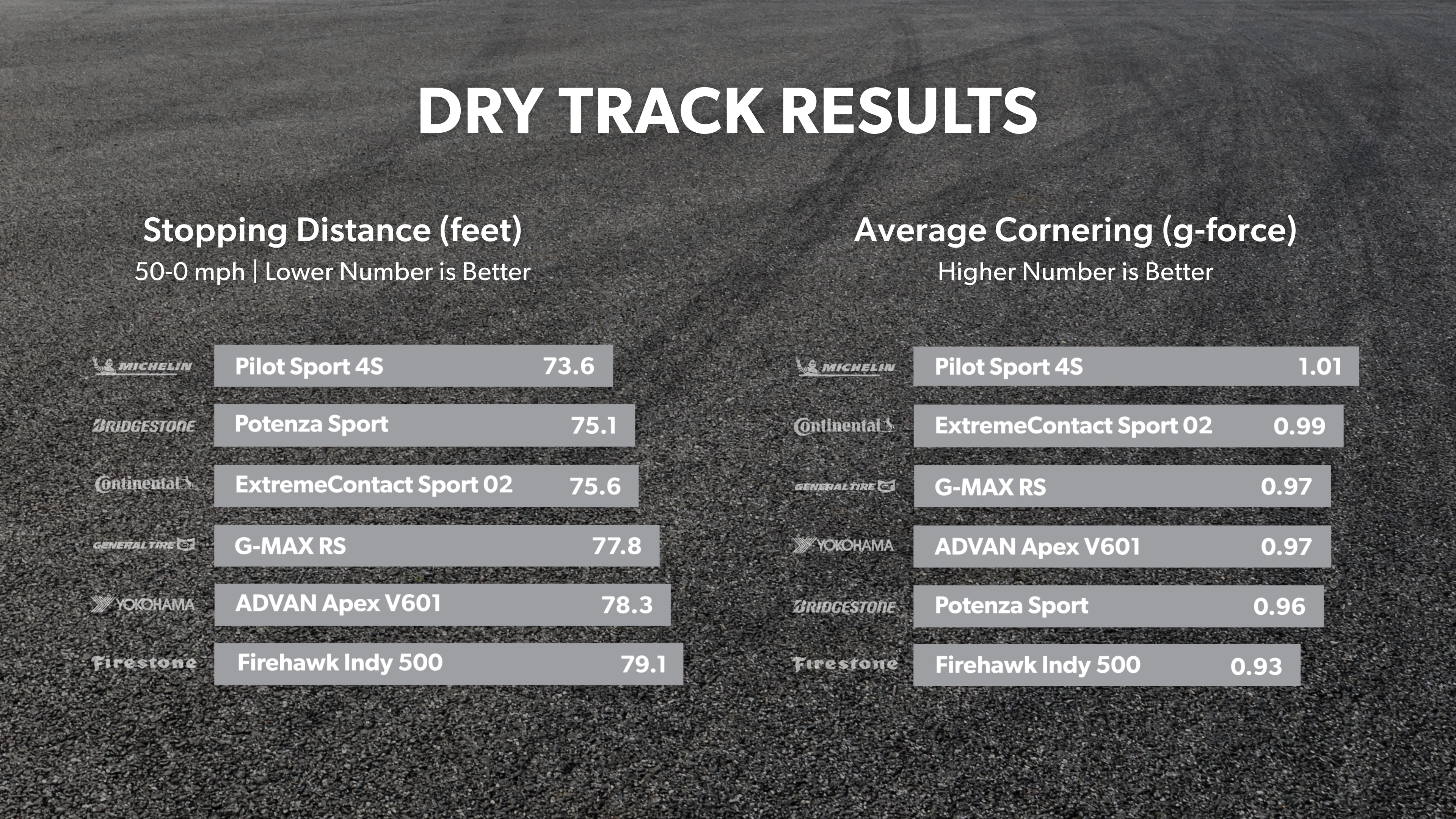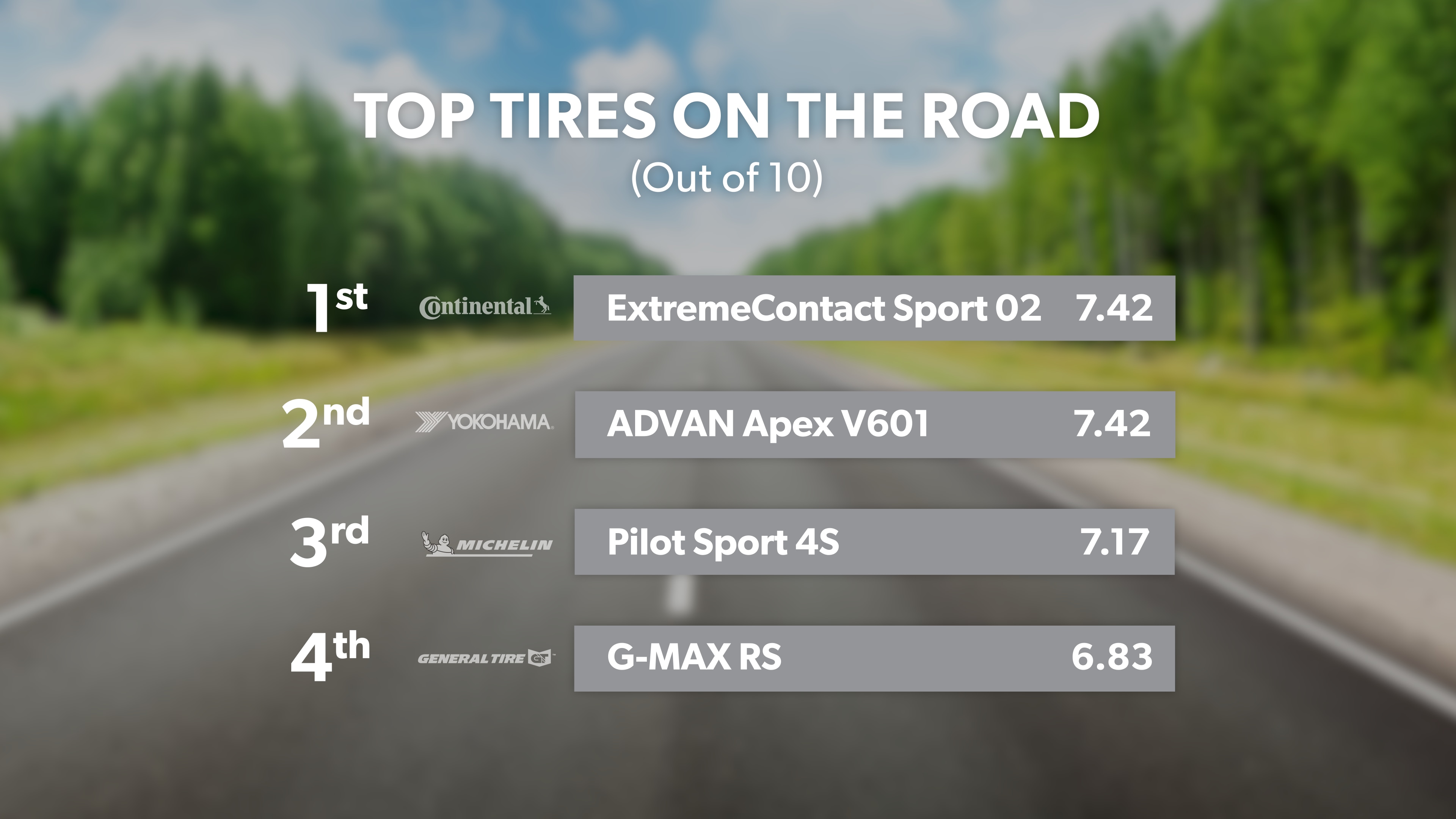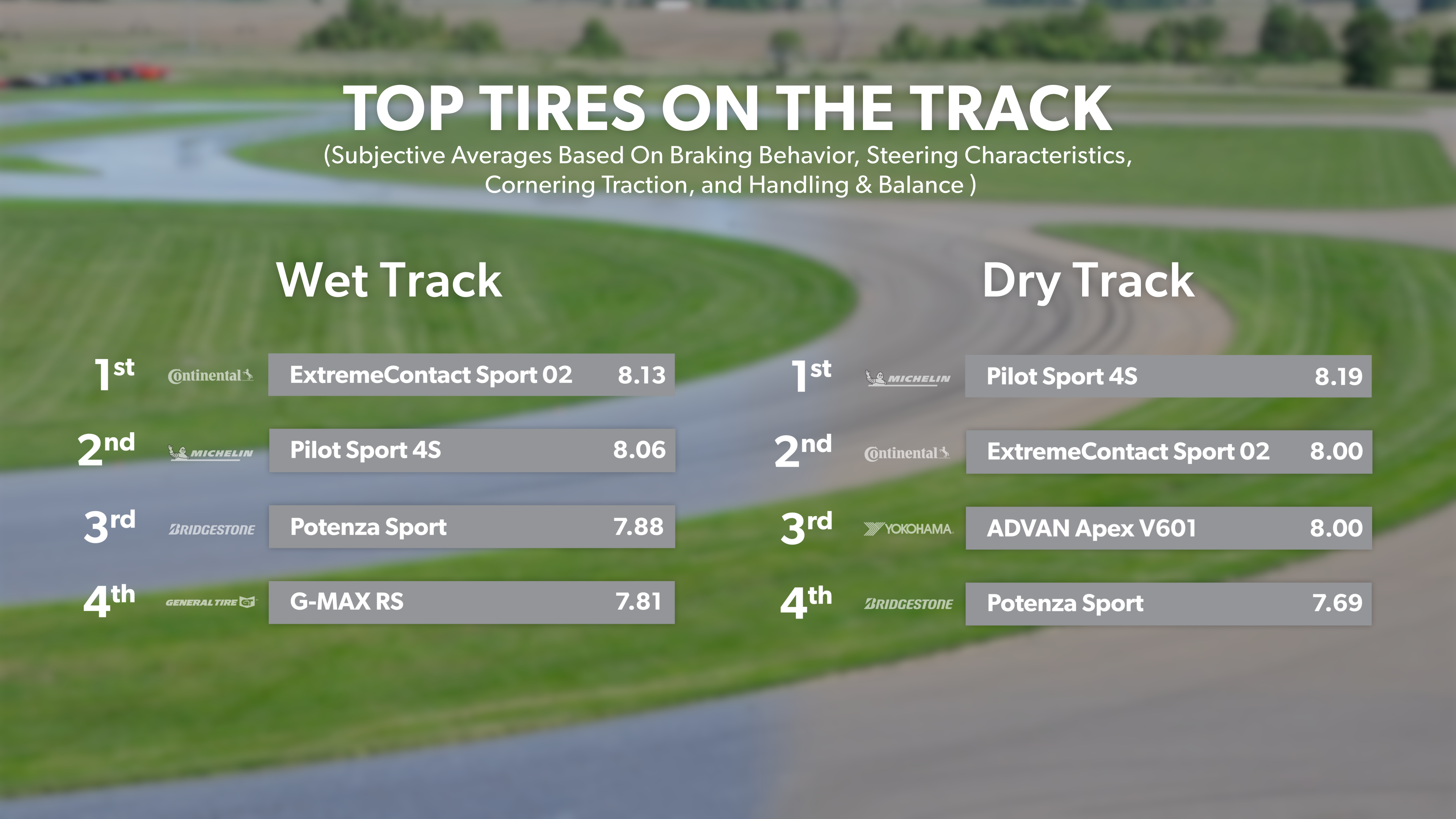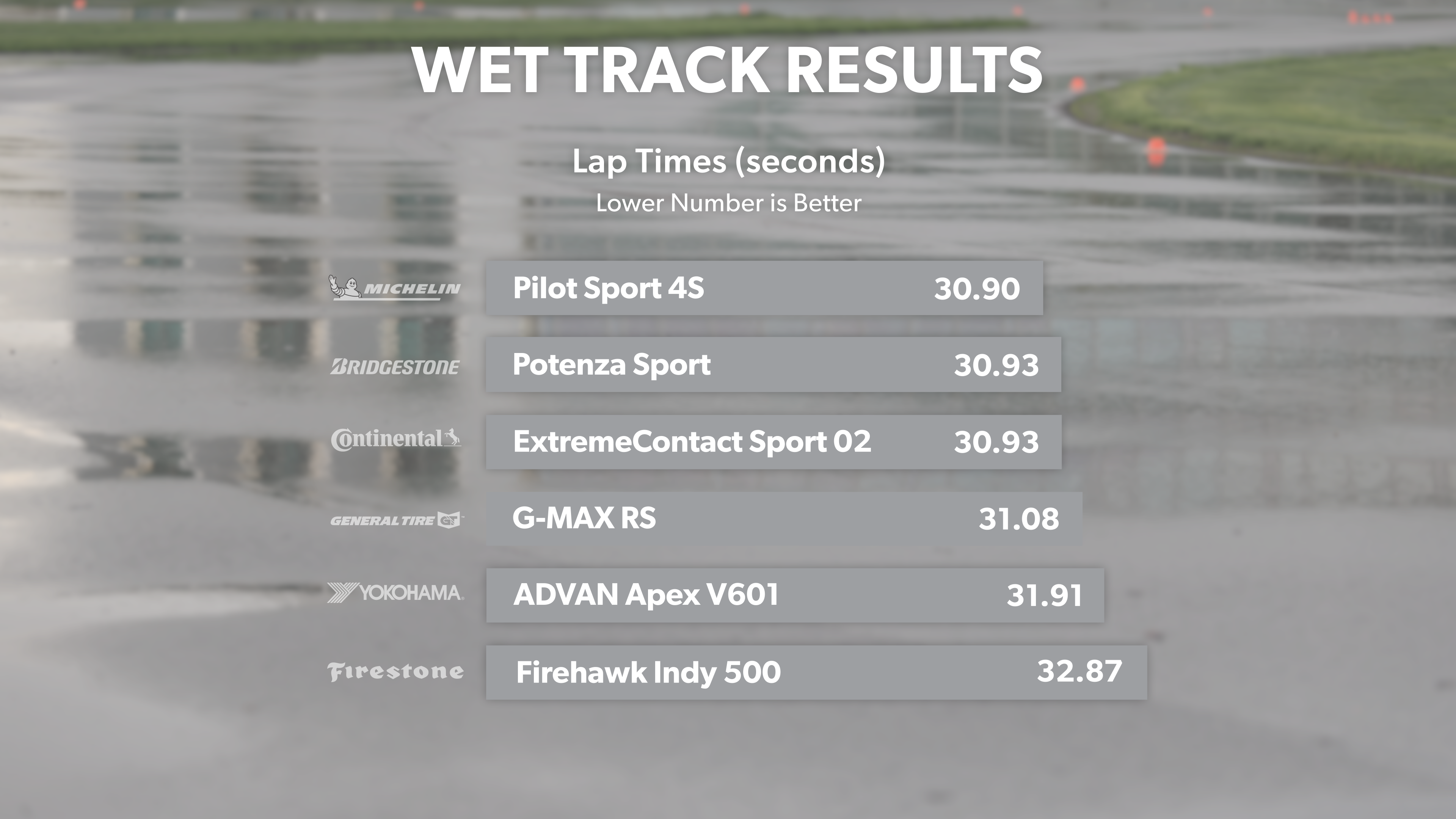This is our first official test on our new BMW M2 test vehicle - a joyful little track-blasting coupe that we've found to be well-matched for pushing the highest echelons of road-worthy tires to their limits while still calming down just enough for a quick grocery run. It's an ideal pairing for the characteristics of the tires we're evaluating here.
Max Performance Summer tires showcase the zenith of their manufacturers' summer street tire technology, embodying the exceptional engineering prowess of their designers. These tires deliver outstanding performance on the road with refined agility and unparalleled dry traction that can harness the power of some of the most formidable vehicles ever sold alongside consistently top-tier wet traction. Similarly, Ultra High Performance Summer tires offer a remarkable blend of versatility and reliability, adapting to various conditions while maintaining superior performance. Both categories feature tires with unique characteristics that aim to be at the top of their field, with an ideal nudge toward comfort or performance in either direction. There's no question these tires tend to be some of the best the industry offers, but how does each distinct personality manage to make this happen?
We'll introduce each, break down our experiences with them on our real-world road ride, then discuss their traction and subjective behavior on both a wet and dry track to understand how these tires act when pushed to their limits, mimicking the kind of high-speed emergency maneuvers you might need to deal with in a sudden crisis.
Bridgestone Potenza Sport
One of the Max Performance Summer tires in this test, the Potenza Sport, has been tested by our team in the past, and while the steering has always been a highlight, it has typically been its main highlight above the tire's other characteristics. On the road this time around, our drivers reported a very firm ride, where even small impacts like road patching would jostle the occupants. They were brief and controlled, but the tire's tendency to make everything on the road an experience made them frequent. It was noisy, too, not overly loud, but there were distinctive tones on most sections of the route. The steering remained the drive's highlight - it tended toward feeling almost too responsive for a daily driver, but for the more sport-minded (or sport-aspiring) driver, its smooth, responsive, and progressive effort through each lane change, turn, and off-ramp was appropriately eager.
On a wet track, that great steering and immediate response combined well with high grip levels, allowing for greater speed as it sped through laps. However, that turned out to be a double-edged sword, and it could be easy to get cut on its edginess. When past the limit, grip loss was abrupt, typically manifesting as understeer but just as capable of snapping back around in the other direction. Slowing down in response, the grip would come back and "catch" you, but that required a lot of uncomfortable faith to make the most of it. The experience was very similar in the dry. It was fast in both, pushing extremely competitive lap times with the group, very nearly, but not quite taking the top spot in most objective measurements, times, and braking distances.
Continental ExtremeContact Sport 02
Another well-loved Max Performance Summer tire, the ExtremeContact Sport 02, has consistently topped customer review rankings and impressed in testing since it debuted. Taking it out on the road with the new M2, one of the first things that our team noted was the ride quality - particularly for a tire in this category, the ExtremeContact Sport 02 was able to absorb impacts and cushion against smaller bumps gracefully. Noise was well-mixed, muting any distracting tones into the sound of travel without raising the volume in the cabin to obnoxious levels. The steering was fluid and natural for a regular commute, with a solid on-center feel that required a bit more input to elicit a response in either direction. It felt planted in a sophisticated, intuitive way. Ready to move, but not overeager.
On the wet track, that same calm, well-balanced attitude persisted. Despite the reduced traction of the wet surface, the steering response allowed our drivers to chain together movements in fluid, predictable ways. When pushed over the limit, the breaking point was a gentle fade into oversteer, and then would just as smoothly recover back into the proper direction. If there was a single word that was consistent in our drivers' notes from wet and dry testing, it was "natural." With the track dried off, the ExtremeContact Sport 02 was even faster, allowing our drivers to put up the best lap times of the entire test on average. The steering was ever-so-slightly less accurate on the dry track, but overall performance was exemplary.
Firestone Firehawk Indy 500
The Firehawk Indy 500 needs almost no introduction. It's a venerable member of the Ultra High Performance Summer category, and with well over 8 million reported customer miles driven at the time of testing, it's one of the most popular tires in the category by far. So, how did it perform on the M2? On the road, it felt taut on rough surfaces, transmitting impacts clearly. Noise was mixed but in the mid-range in terms of volume, with a constant mid-level grind on concrete and some vibrato on most surfaces, though it blended noise respectably over asphalt. Steering was quick and light but required frequent minor corrections, lacking weight and precision. Overall, handling was eager but could benefit from more stability and natural feel.
Switching over to the wet track made clear a glaring difference in overall traction among the group, as it felt more like gliding around through laps than being firmly planted. Steering was quick and light when there was grip, but the tire became twitchy and eager to slide when pushed beyond its limits. That isn't to say it wasn't controllable - the braking and lateral traction were well-matched, so it was largely predictable but lacked the ultimate traction needed to compete, resulting in less grip for acceleration and longer braking distances. This remained as true in the dry as it was in the wet, if not even a little worse, with the Firehawk Indy 500 just struggling to put down power. When it did, it had to be carefully managed to stay within the limits and avoid combining inputs in order to keep from suddenly pushing into understeer. Overall, it could be fun to drive, but it did not stand out in terms of grip or precision.
General G-MAX RS
The only other Ultra High Performance Summer tire in this test, the G-MAX RS has been a hit with consumers, and largely satisfied in testing in years past. So, how does it fare revisiting it today? Well, the road ride showed us tires that, while taut and likely to give some up-and-down motion over bumps, kept that motion to a minimum. It was controlled, composed, and succinct. The driving noise came from various sources, including a slight "boom" over impacts - most surfaces produced either noticeable or additive tones that resulted in a higher volume of noise overall. Even in portions of the ride where tones were well-blended, like at higher speeds on the bypass portion, it was still up in volume. Steering was in line with most other aspects of the ride: good, but not great. Compared to most of the other tires in this test, it wasn't as aggressive or responsive and felt somewhat sluggish immediately off-center. The more input it took, the further into a turn it went; the build-up felt more linear and direct, but as a whole, it was just... fine.
Switching over to the wet track was a different experience, and the steering felt speedy and much more direct. While still not perfectly precise, it was much more balanced under stress than its on-road behavior. The absolute grip was strong, and braking was competitive with tires that were technically a performance category beyond it - our drivers could push the G-MAX RS to its limits and still comfortably rein it in. It was similarly athletic and capable on the dry track but started to fall off as the tires heated up. It wasn't so drastic that it would affect average drivers significantly, as the loss of performance and grip was holistic and still balanced, but it was a noticeable quirk of the tires.
Michelin Pilot Sport 4S
The Pilot Sport 4S is, almost inarguably, one of the most well-known tires in this test. It has routinely occupied, or at least shared, the top of Consumer Recommended options and - while certainly not a perfect tire - has consistently tested well over the years. Still, it's a new vehicle and a new year, so how did it do this time around? Out on the road, the Pilot Sport 4S provided a firm to outright stiff ride, transmitting every crack, bump, and undulation to the occupants without muting or rounding them off. Impact noise was noticeable, though overall noise comfort remained reasonable on smoother asphalt but louder over concrete sections, with underlying cyclical notes on certain surfaces. Despite these issues, the steering was excellent—quick, natural, athletic, and responsive, with a nice, hefty feel. However, overall ride quality and noise levels were disappointing for a top-tier tire.
Switching over to the wet track, the Pilot Sport 4S demonstrated superb steering, great traction, and strong braking but suffered from chattery understeer, especially on corner exit. While corner entry and mid-corner traction were excellent, the tires pushed and chattered when exiting corners, requiring more braking than expected. This chattering affected both front and rear tires, causing lateral pushes and vibrations that hindered recovery. Despite these issues, the tire was still fast and effective, leading the other tires in objective lap times and braking distance. This was just as true in the dry, where the chattering behavior was just as present over the limits, though, also just as true in both, as long as the Pilot Sport 4S kept within its comfort zone, it was still very good.
Yokohama ADVAN Apex V601
The ADVAN name represents the pinnacle of Yokohama's performance and motorsport engineering, and it is a name they reserve for their best - and in particular, the ADVAN Apex V601 made waves a few years ago as the first ADVAN tire to be designed specifically for the North American market. On our road ride, the ADVAN Apex V601 effectively rounded over repetitive bumps and small imperfections while maintaining a stiffer, composed feeling typical of performance tires. It produced a fairly common light growl on concrete, though it blended noises well while on coarse asphalt at highway speeds. It was surprisingly quiet on smoother sections, almost comparable to a good touring tire. The steering was responsive and loaded up well, though it could benefit from some added heft and a hair more aggression.
When it came time to examine the tire on a wet track, it was a bit of a mixed bag. Its strong attributes shone, as the steering under pressure was bright, alert, and responsive, with great front axle authority. Still, the rear struggled to keep up in the corners, making it twitchy during power transitions. It handled cornering well but had an imbalance between lateral and longitudinal traction, turning better than it would brake. Its braking in the wet was very near the back of the pack in objective terms. On the dry surface, while not strictly a performance consideration, our testers noted that the tire was loud, squealing its way through the track. It felt pushy when traction was lost, but overall, it provided a good, balanced experience with solid grip and natural steering despite some noticeable imbalances.
Summary Conclusion
Although we've examined all these tires previously, it's worth noting that, just like different shoes work better for different people depending on preference, pronation, gait, and so on, there's no "best tire" for every car in the same way there's no "best shoe." Testing Ultra High Performance Summer tires alongside Max Performance Summer tires and the new vehicle gives us valuable insight into each while keeping our data current and as broadly comparable as possible as new tires enter the testing cycle.
The Continental ExtremeContact Sport 02 is a tire that is difficult to say enough good about. It manages to be comfortable on the road and capable of securely handling any situation or maneuver asked of it without getting out of sorts. It does its job well as a Max Performance Summer tire, but without forgetting that driving should be enjoyable even when it isn't pedal-to-the-floor. Michelin's Pilot Sport 4S takes a more focused attitude here, and it has the objective scores to back it up, with great dry performance bolstered by test-leading lap times and braking distances in the wet. There's no questioning its performance chops, and for many drivers, the trade-off in on-road comfort is worth getting every drop of power out of their vehicles.
Yokohama's ADVAN Apex V601 feels more like it's chasing, or perhaps echoing the ExtremeContact Sport 02, with its on-road comfort rivaling the Continental tire in subjective evaluation. It's not a bad performer either - and would be an easy rival for most of the tires in this test around a dry track, even if you could hear it gaining well before you could see it in your mirrors. However, its behavior in the wet needs attention, as it lagged well behind its categorical peers, but to brake further and lap slower than an Ultra High Performance Summer tire is hard to ignore. The General G-MAX RS, in many respects, benefits enormously from being compared to Max Performance Summer tires. We expected some qualitative differences between the categories, but for it to perform as closely as it did with its peers in the test is a strong credit to the tire. It might not be the technical best in this arena or any one category, but as a value proposition to be competitive, it's an enticing option.
As a Max Performance Summer participant, Bridgestone's Potenza Sport has certainly been popular with customers and has shown it can perform at a high level with excellent braking and cornering traction; there's no question it's an eager rival. That eagerness, notably in the Potenza Sport's aggressively fast steering, is its strength and weakness, as it doesn't feel as properly mated to the tire's other characteristics to make the most of it in a smooth, professional way. The reality that it has also sacrificed a good deal of on-road comfort along the way only hurts a tire that is, by all accounts, still very good at what it does. Finally, the Firestone Firehawk Indy 500 is a classic example of what has, by most accounts and thousands of reviews, been a darn good tire for a long time. Like an old boxer that still has knockout power, the champion's soul is in there, but time and technological development wait for no one; there really wasn't any metric in this test that it could keep pace with the other tires on, including its Ultra High Performance Summer peer. It was never so far off that, as a value consideration, it wouldn't be worth a look, but at this tier of competition, drivers are rarely looking to settle for "pretty good."


